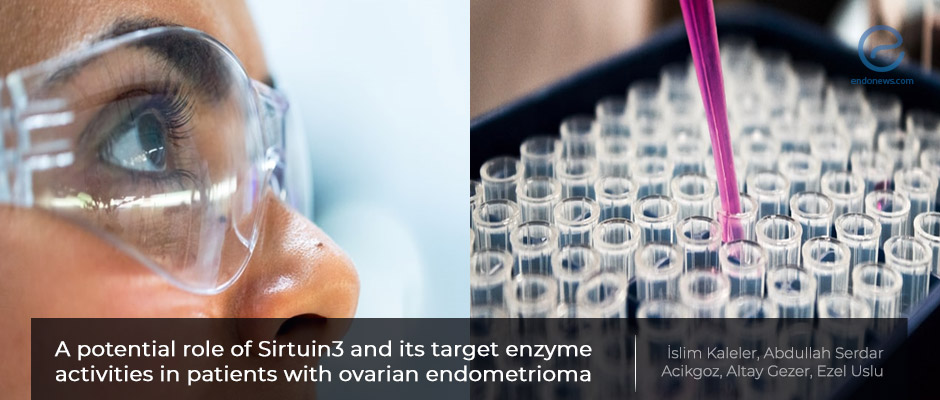“Sirtuin-3” as a novel target in endometriosis pathogenesis
Nov 4, 2021
The protein "Sirtuin-3" and its target enzymes are shown to play important roles in ovarian endometrioma patients
Key Points
Highlight:
- Sirtuin-3 is a deacetylase enzyme in mitochondrial metabolism, may be considered as a new target in endometriosis pathogenesis.
Importance:
- The mitochondrial cycle is crucial in cell metabolism and the balance between oxidative stress pathways and antioxidants plays an important role in the pathogenesis of many diseases.
- SIRT3 and its target enzymes glutamate dehydrogenase, succinate dehydrogenase, and manganese superoxide dismutase are important in the oxidative stress - antioxidant system.
- The balance of this system is known to be impaired in endometriosis.
What’s done here
- This is a case-control study of 30 women with ovarian endometrioma where the role of SIRT3 and its target enzymes was investigated in the pathogenesis of endometriosis.
- Endometrial tissue and serum samples of the patients and the controls were evaluated in the process to determine the enzyme levels.
Key results:
- SIRT3 was found to be decreased in the tissue samples of the patients with ovarian endometrioma whereas not in the serum samples.
- SIRT3 is thought to have a role in cell metabolism and antioxidant mechanism in patients with ovarian endometrioma.
- Succinate dehydrogenase and glutamate dehydrogenase enzyme activities were decreased in the tissue samples of ovarian endometriosis patients.
- Mitochondrial fraction analysis provided similar results.
Lay Summary
The energy that is needed for a normal cell function is produced in the mitochondria. While producing this energy, a complex and cyclical process occurs with many proteins and enzymes. Enzymes such as glutamate dehydrogenase and succinate dehydrogenase play important roles in mitochondrial metabolism namely oxidative phosphorylation which is responsible for the formation and the mediation of reactive oxygen species. The activities of these enzymes are regulated by some acetylation and deacetylation reactions. Sirtuins are a protein family that takes part in this process.
The major deacetylase is SIRT3 which regulates the mitochondrial metabolism and plays an important role in reducing oxidative stress by affecting the levels of cellular reactive oxygen species. Manganese superoxide dismutase on the other hand is the major mitochondrial antioxidant enzyme and its deacetylation by SIRT3 causes a decrease in cellular reactive oxygen species levels. SIRT3 is known to have protective effects on the progression of many diseases. Endometriosis is a disease where the balance between reactive oxygen species and antioxidants is known to be impaired, however, the mechanisms that cause this are still unknown.
In a study by Kaleler et. al, serum and endometrial tissue samples of 30 women with ovarian endometrioma and 26 women without endometriosis were gathered in order to determine the effects of SIRT3 and its target enzyme activities and their possible association with the pathogenesis of ovarian endometrioma. The study was published in the September 2021 issue of the journal Gynecological Endocrinology.
The results of the biochemical analyses revealed that the tissue sample concentrations of SIRT3 were significantly lower in the patient group however the difference in the serum samples was not statistically significant. The levels of glutamate dehydrogenase, succinate dehydrogenase, totalsuperoxide dismutase, Manganese superoxide dismutase enzyme activities were decreased in the tissue homogenate of endometrioma patients. Contrarily, Cu/Zn superoxide dismutase activity was increased. The mitochondrial fraction levels of the same entities were also analyzed.
The researchers further discussed and emphasized various functions of SIRT3 in tumor suppression, tumor promotion, aging. What is more, it has roles in the suppression of cell migration, metastasis, and invasion in ovarian carcinoma. It is also thought to have a role in the cell metabolism and antioxidant mechanism in patients with ovarian endometrioma.
The authors conclude that this study is the first one that evaluates the role of SIRT3 and its target enzymes in ovarian endometrioma patients. Its promising results may help in understanding the role of mitochondrial activity in endometriosis pathogenesis.
Research Source: https://pubmed.ncbi.nlm.nih.gov/34514931/
Sirtuin-3 glutamate dehydrogenase succinate dehydrogenase oxidative stress endometrioma

